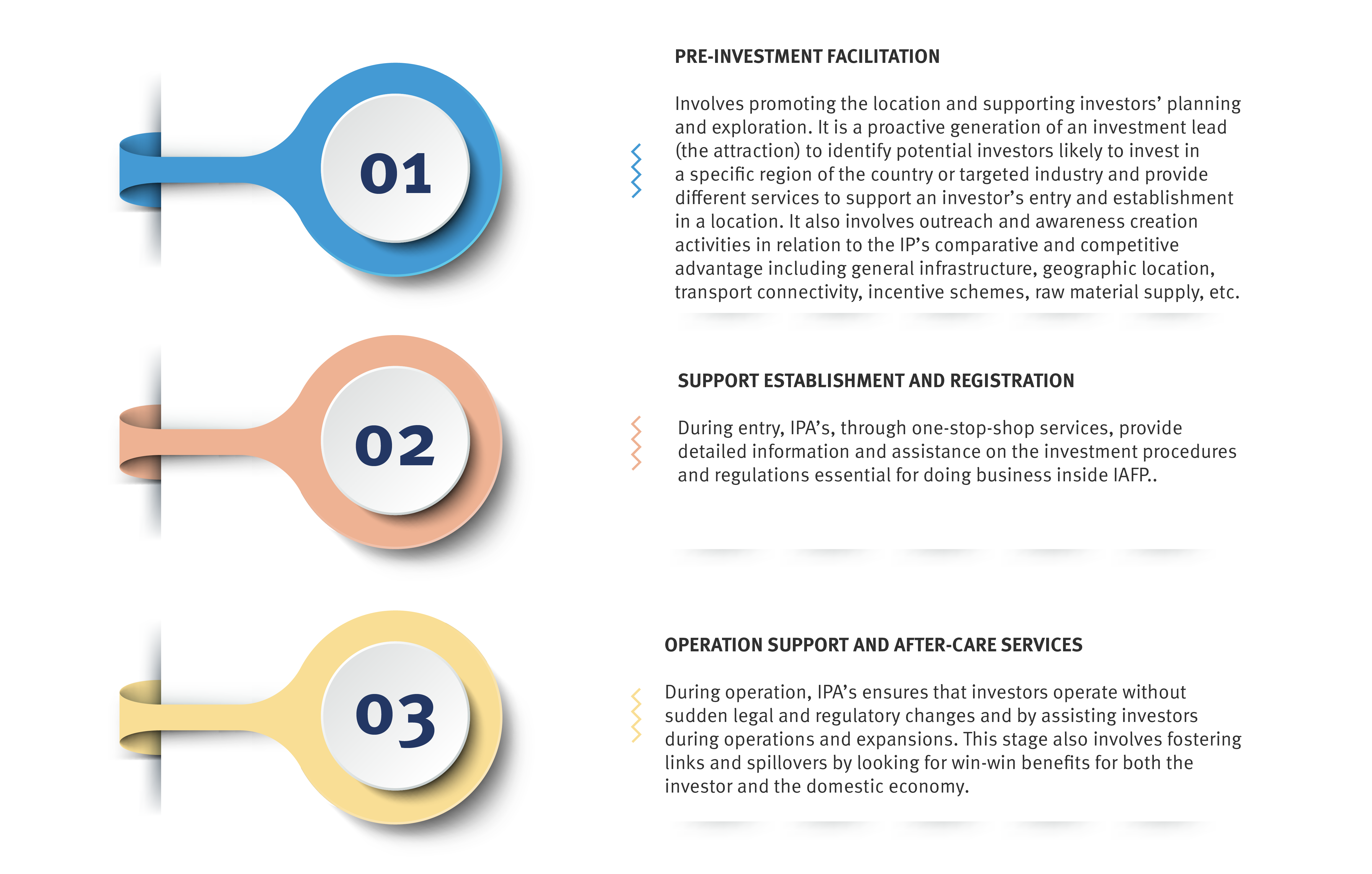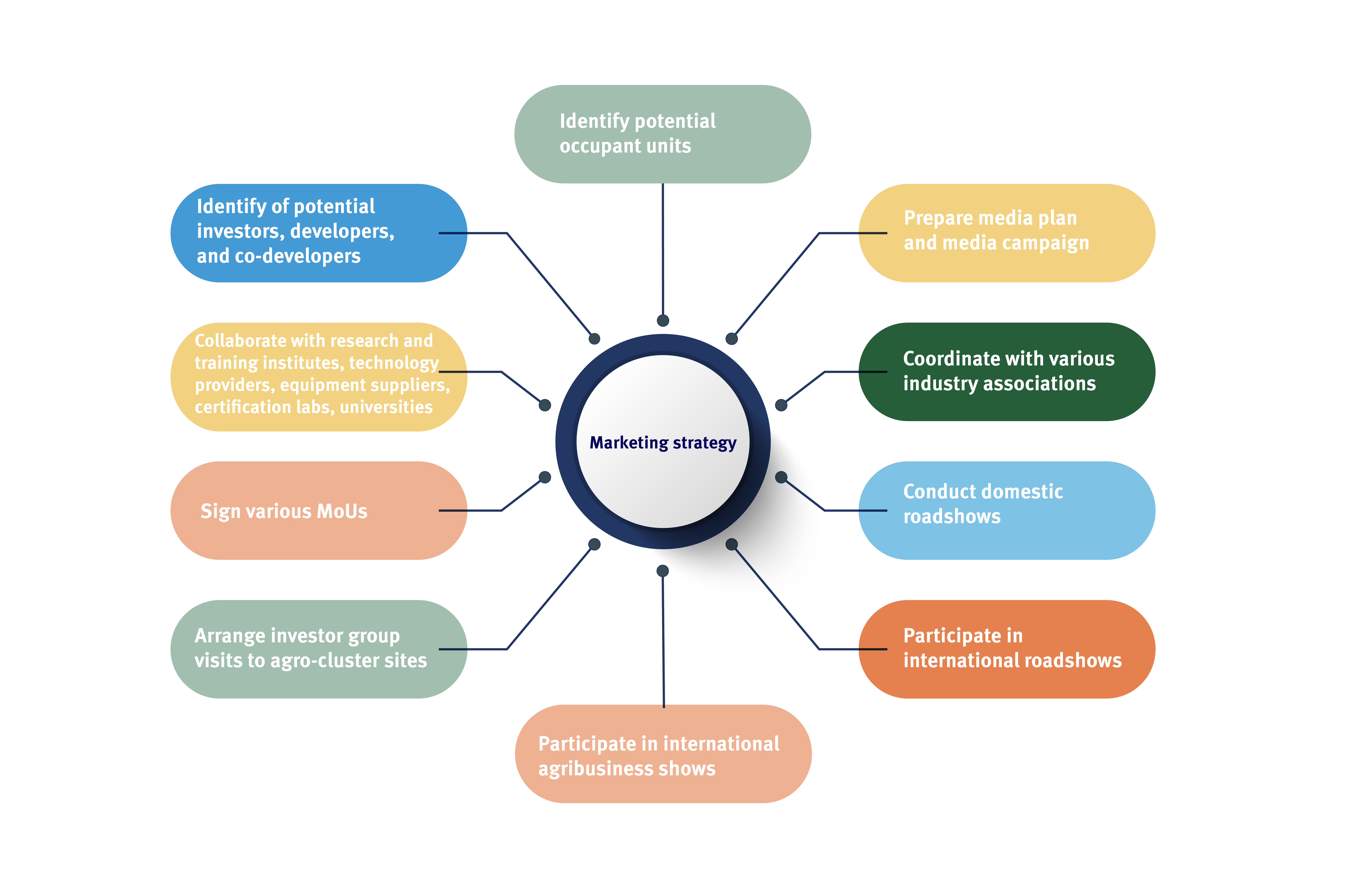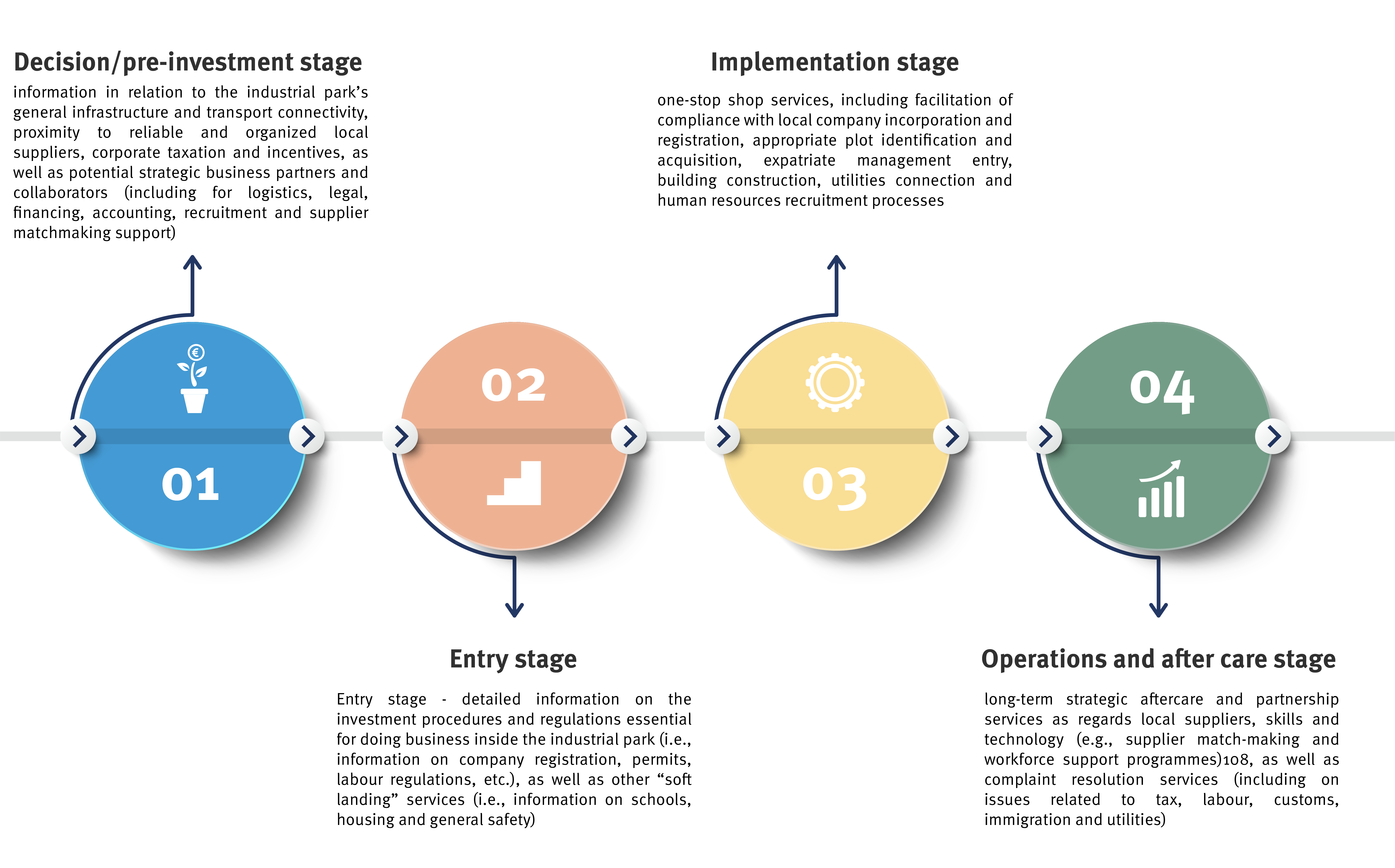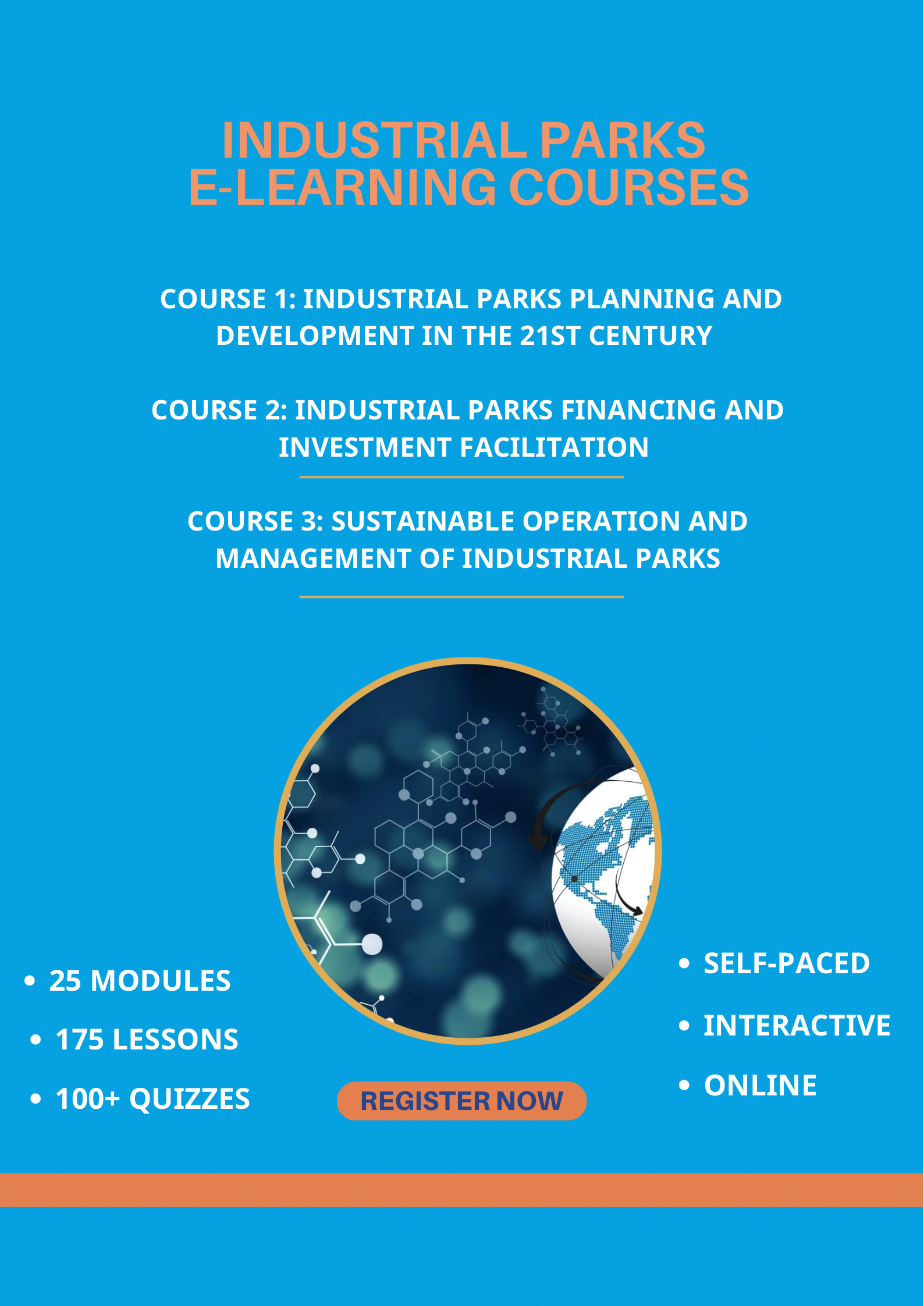P Phase five - Investment promotion and marketing
Investment promotion, attraction and facilitation is a crucial cross-cutting phase in the industrial parks programme life-cycle. Some of the core activities in this phase include:

Studies confirm the effectiveness of investment promotion as a relatively “safe” and non-distortive industrial policy tool whose impact on FDI can be significant. Results suggest that sectors targeted through specific investment promotion campaigns receive on average more than twice as much FDI inflow as non-targeted sectors and that the cost-benefit of investment promotion is highly positive as compared with other policy measures. Investment promotion tools include the following:
-
Fact sheets, videos and information briefs that seek to attract the interest of potential investors in a specific industrial park
-
Newsletters that inform their target audience of investment developments, construction progress, plans and events related to the industrial park, typically circulated on a monthly or quarterly basis
-
Media and public relations activities and investment success stories that inform the domestic and international media, as well as select audiences, of upcoming events and favourable policy developments as regards industrial parks. These may entail press, radio and television briefings, conferences, organized inbound and outbound tours for national and international journalists, and tours by government representatives to promote the industrial park programme in foreign markets
-
A dedicated website and suite of social media channels
-
Mobilization of the network of a country’s diplomatic channels, as embassies and consulates are very often the first point of contact for potential foreign investors.

A key risk in investment promotion campaigns relates to proper timing. Premature campaigns based only on mock-up versions of the industrial park master plan lack transparent and verifiable information regarding a park’s readiness to receive investors. Promotion campaigns are therefore usually ineffective unless the construction work on an industrial park is in its final stretch. Another common impediment to effective investment promotion relates to coordination among stakeholders.
Elements of successful investment promotion activities

In an attempt to ensure that industrial park investment measurably contributes to its host country’s economic development, some nations set performance criteria tied to the conditions and industrialisation level of the economy.
The issue of performance requirements is a contentious one, as their older and more traditional forms (e.g., export, equity, local employment, technology transfer and local content requirements) are inconsistent with the WTO Trade-Related Investment Measures (TRIMS) and Subsidies and Countervailing Measures (SCM) agreements which entered into force in 1995. That said, new industrial policy (NIP) approaches see moderate performance requirements as a legitimate means to spur and channel desirable investor behaviour and to attract FDI in strategic and specific industrial “sectors”, of a specific “size” and in specific geographical “spaces”. A particular feature of NIP is this “Triple-S specificity”. Such performance requirements should moreover be time-bound and well-justified (e.g. infant industry protection) and follow a path towards gradual relaxation. Still, performance requirements are more often applied in LDCs that have more flexibility as to their use, due to the exceptions that the international rules-based trading system allows for developing countries.
The first few years following an enterprise’s establishment are critical to its survival and development. Thus, supporting the enterprise both during as well as after the establishment phase is of prime importance. There is an overall consensus that the mandate of IPAs must go beyond mere marketing towards investment facilitation in order to have a lasting impact on FDI inflows and retention.
Successive UNIDO investor surveys and reports have consistently found that a proactive and strategic approach to investor aftercare is unfortunately still the exception. The norm, especially in developing countries, is often to only offer investment advisory and support services for FDI entry, in order to assist foreign investors in navigating host country licensing and permitting processes. As important as this function may be in attracting new FDI, harnessing “quality” FDI in the medium to long-term requires a shift to investment facilitation aimed at securing the re-investment of earnings by existing investors, which is all too often neglected106. The prevailing approach also unnecessarily favours FDI over domestic investment.
UNIDO classifies investment support into four phases: the decision/pre-investment stage (Phase 1), the entry stage (Phase 2), the implementation stage (Phase 3) and the operation/aftercare stage (Phase 4):

The effective delivery of aftercare is aided by a communications strategy including such elements as regular investor surveys and a customer relationship management (CRM) system, providing the industrial park operator with information on residents’ strategic business focus, operating climate perceptions and expansion plans. The effectiveness of aftercare support programmes also depends on industrial park planning-stage site selection, which should take into account the proximity of reliable and organized local suppliers and labour markets, as well as proximity to regional transformation hubs if the parks will not act as such hubs themselves
High-quality investment facilitation during all four phases (and particularly during Phase 4) can set off several cycles of sequential investments linked to one or more expansion projects. It is important that industrial park operators and the government recognize this in their efforts to better satisfy investor support services needs throughout the various stages of their investment lifecycle.
At the national level, unless a country has established a powerful and independent industrial parks authority, investment support should be provided by the line ministries, and related statutory and regulatory agencies, mandated to adopt policies and to deliver administrative services to industrial parks and their residents, preferably through a standing committee that ensures these stakeholders are informed of each other’s plans and actions, and take coordinated decisions.
At the local level where an industrial park is located, the interaction and coordination of concerned regulatory entities, local government authorities and the operator is imperative as well, notably to provide on-site one-stop-shop services. Moreover, the industrial park operator should coordinate with regional-level private sector associations in its investment promotion efforts.
While there is no one-size-fits-all solution, there are different instructional settings for industrial parks investment promotion and facilitation. Many countries have centralized investment promotion agencies, which may or may not have a network of subnational offices. Others, often with more decentralized governance systems, establish local investment promotion agencies (IPAs) that are partly or fully independent from the central agency.
Industrial parks are inherently complex systems comprising numerous users, which all interact with an operator, a host community and various regulators, requiring compliance with a large number of protocols, rules and standards.
The potential risk associated with the development of industrial parks occur in three broad development phases:
Implementation
during contract and construction phases
Planning stage
at which point there is a need to convince the government to undertake the venture; Implementation — during contract
Operations phase
at which point IAFPs and constituent units are in operation.
The risks that industrial parks present are better managed when analyzed using a systematic approach to identify, prioritize and mitigate them. Clear risk identification, prevention and mitigation plans at both the company and park level are critical.
A sound risk management plan includes risk prevention and limitation measures, actions in case of incidents, responsible partners and required communications actions.
To this end, management plans should include a definition of the responsibilities of all the concerned stakeholders. Clear decision-making processes and protocols should furthermore be established. Moreover, national occupational health and safety, environmental, accident and disaster compliance requirements must all be fulfilled, as well as compliance with the safeguards of the international agencies that have made a financial contribution to the industrial park. Finally, Industrial Park Management and the park’s resident enterprises must also ensure their employees are informed of their responsibilities before any incident occurs.
Our focus
Explore
Contact us
UNIDO cross-disciplinary team on industrial parks (CDTIP)
Vienna International Centre
sipp@unido.org


